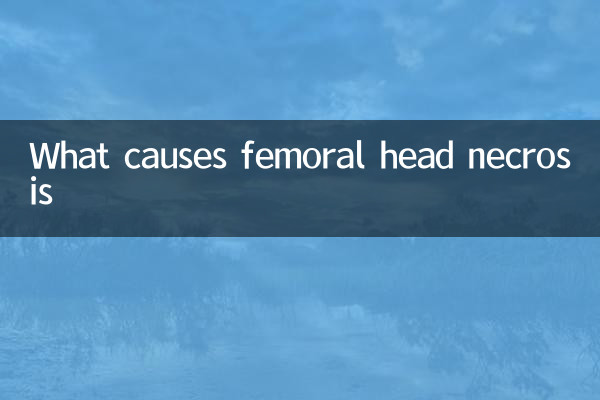What causes femoral head necrosis
Avascular Necrosis of the Femoral Head (ANFH) is a disease of bone tissue death caused by insufficient blood supply to the femoral head. In recent years, this disease has become a hot topic in the medical field due to its high disability rate and complex treatment methods. The following is a detailed analysis of femoral head necrosis, including its causes, symptoms, complications and treatment methods.
1. Causes of femoral head necrosis

The causes of femoral head necrosis are diverse, mainly including the following categories:
| Type of cause | Specific reasons |
|---|---|
| Traumatic factors | Blood supply interruption due to hip fractures, dislocations and other trauma |
| Non-traumatic factors | Long-term use of hormones, alcohol abuse, hypertension, diabetes, etc. |
| Other factors | Genetic factors, radiation therapy, blood diseases, etc. |
2. Symptoms of femoral head necrosis
Symptoms of femoral head necrosis are usually divided into early and late stages:
| stage | Symptoms and manifestations |
|---|---|
| Early | Hidden pain in the hip or groin area will aggravate after activity and relieve rest |
| Late | Increasing pain, limited joint movement, limp, and even unable to walk |
3. Complications of femoral head necrosis
If left untreated, femoral head necrosis may lead to the following serious consequences:
| complication | Specific performance |
|---|---|
| Hip dysfunction | Stiff joints and reduced range of motion |
| Osteoarthritis | Wear of articular cartilage, further aggravating pain |
| Shortening of limbs | The femoral head collapses and causes inconsistent length of lower limbs |
| Disability | Rely on a wheelchair or crutch in severe cases |
4. Treatment methods for femoral head necrosis
According to the severity of the disease, the treatment methods can be divided into conservative treatment and surgical treatment:
| Treatment method | Applicable stage | Specific methods |
|---|---|---|
| Conservative treatment | Early | Drug pain relief, weight loss, physical therapy |
| Surgical treatment | Middle and late stage | Decompression of the marrow core, bone grafting, artificial hip replacement |
5. How to prevent femoral head necrosis
The key to preventing femoral head necrosis is to avoid high-risk factors:
Conclusion
Femoral head necrosis is a serious orthopedic disease, and early detection and treatment are crucial. If you experience hip pain or limited movement, you should seek medical treatment in time to avoid worsening of the condition and disability. Through scientific treatment and preventive measures, the risk of femoral head necrosis can be effectively reduced and the quality of life can be improved.

check the details

check the details